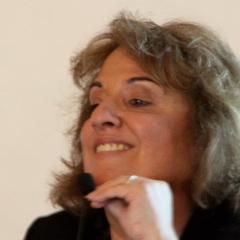 Carol Forgash, LCSW is the author of Healing the Heart of Trauma and Dissociation with EMDR and Ego State Therapy and a former board president of EMDR Humanitarian Assistance Programs. She talked to WTCI via email about her work in the U.S. and around the world.
Carol Forgash, LCSW is the author of Healing the Heart of Trauma and Dissociation with EMDR and Ego State Therapy and a former board president of EMDR Humanitarian Assistance Programs. She talked to WTCI via email about her work in the U.S. and around the world.
What’s your background?
I grew up in Brooklyn, was a Dodger fan, had a country life every summer in the Catskills
I am a former elementary school teacher (2nd and 3rd grade) and occasional substitute music teacher. I love music and played piano and sang in choirs in earlier years. Became a mother (two sons) and a community volunteer (through the league of Women Voters). I became a clinical social worker in my late 30s, completed an MSW at Adelphi University. In the 1980s, I worked for the NY State mental health system in outpatient clinics and immediately realized that many of my clients were trauma survivors, predominantly from child abuse. The diagnosis of PTSD was developed at that time and I was a “gadfly” who kept saying, “Look at that person as not the ten different diagnoses you’ve given them–they are someone who reports trauma and they have symptoms of PTSD. They are frequently dissociative and have symptoms that appear to be other disorders (comorbid).
I began to develop courses–in diagnosing and treating PTSD and dissociation, and also in assessment and treatment of sexual abuse survivors–and presented them through county and state mental health training venues. I began to see clients in private practice, specializing in work with sexual abuse survivors. About 15 years into my career, I took EMDR training and qualified as an EMDRIA Approved Consultant and an EMDR Institute Facilitator.
What do you do now?
After 30-plus years in the mental health field, I now have a part time practice. I work extensively with EMDR working with survivors of many kinds of traumas, with people with health problems and more general issues. I developed two advanced EMDR courses which I present as two-day workshops (The EMDR Treatment of Health Related Problems, and Healing the Heart of Trauma with EMDR and Ego State Therapy [also a DVD distance learning course]) in the U.S. and internationally. I’m going to Melbourne, Australia in June to present both workshops.
I’ve always worked with dissociative clients and found that using an ego state approach [see site] integrated with EMDR offered this group a comprehensive way to teach them how to deal with dissociative symptoms, deal with issues of fragmentation, and prepare to work on trauma issues. John and Helen Watkins’ book, Ego States: Theory and Therapy, was extremely helpful in educating me to the benefits of working with all clients in this way. I believe that developing an understanding and working with the parts of personality enriches the therapy experience.
That all being said..I am most proud of my affiliation—with EMDR Humanitarian Assistance Programs. I was a board member for eleven years and Board President for six. HAP’s mission is to end the cycle of trauma by providing EMDR trainings to clinicians who work for non-profit agencies and serve underserved populations in the U.S. (native Americans, inner city, developmentally challenged, military veterans).
We also provide trainings for clinicians in other countries where our goal is to help agencies, NGOs, universities, and government mental health departments develop EMDR Centers of Excellence. Over several years, they will develop experience in EMDR practice, consultation and eventually to provide EMDR training for clinicians. Currently, as an ex-board member, I’m chairing a board recruitment committee and producing DVDs of my two workshops with a HAP board member, Gary Scarborough, for HAP to sell on their web store.
What have been the most challenging and/or rewarding of your efforts with HAP?
One of the most rewarding experiences was a trip to Thailand several months after the tsunami. HAP had presented an EMDR training and I was doing a follow up trip. I arrived in Bangkok and had to speak at a Pacific Region conference on Trauma treatment. I found out that one of my two co-speakers was ill and wouldn’t be coming. The other speaker, Jack McCarthy, now a HAP trainer, I had never met. We thought about 20 people might come to our session, but word spread about EMDR and there was standing room only. We told EMDR stories about natural disasters and mental health disaster relief planning that could be successful if clinicians were trained in EMDR .The enthusiasm in the room was just remarkable, and I knew more than ever that HAP’s training mission was so important.
Since then, there have been many trainings in Indonesia, Sri Lanka, Thailand, India. An EMDR Asia Association is now in place as well as country associations. We now have a new grant which will fund a new training cycle in Sri Lanka. I’m leaving the best for last. When I went to the tsunami area, I watched people having EMDR sessions. The Thai want tapping, not eye movements. Most of them believed that they were sinners because they couldn’t save enough people. Some were refusing to eat, work, interact, had sleep disorders. One by one–in a session or two–they had given up the belief that they were sinners and realized that they had done the best they could. And in fact, many had saved several people as they ran from the wall of water. When I came back the day after, people told me that they had slept for the first time “in months” and they smiled and gave me the same hi-five they gave the therapist in the EMDR session when they realized how much better they felt.
It’s been amazing to tap into the generosity of the community of EMDR clinicians and to be a part of this community. HAP is an all-volunteer group of clinicians. Trainers, facilitators, logistics people. They give up weekends (in the U.S.) and two weeks (international trainings) of their lives, often repeatedly,to participate in EMDR trainings. They also have been our earliest and continuous financial supporters. Our board is fantastic and focused on helping HAP grow, expanding our mission, building a professional organization. No egos ever show up at those meetings.It’s an incredible organization and I’m proud to have been a part of it!
Working in such extreme environments, how have you and others handled becoming overwhelmed–the secondary trauma?
Actually, I went to Thailand several months after the tsunami/earthquake–I was not working in an extreme environment. I even had an air conditioned room. HAP never sends volunteers into dangerous situations (by that I mean, we do not conduct trainings in areas that the US State Department designates as dangerous). Also, it’s important to note that psychological treatment needs to take place only after basic needs for safety, food, water, shelter have been set up. Therefore our trainings will not be set up during that time. Additionally, HAP only trains where invited, usually by NGOs or local institutions. They select the timing of the trainings. There are always debriefings for the trainers and staff to prevent secondary traumatization .
How might people get involved with HAP?
There are many ways to get involved with HAP as a volunteer. Go to www.emdrhap.org to get a great deal of information about HAP. Click “Volunteers”–there’s a comprehensive information page that defines the volunteer roles. Some are clinical and require EMDR training, but many new ways people can volunteer are not clinical. Some, such as our Trauma Recovery Networks, are grassroots and can be developed right in one’s own community. Read about becoming a HAP volunteer and fill out the volunteer data sheet–that will let HAP know about you and how you see yourself as a volunteer.
Of course, donations are always welcome!
Find Carol Forgash on the web at her site, Advanced Education Productions. Also see the EMDR Humanitarian Assistance Program. Find more on the web about EMDR and Ego State Therapy.
An bibliography for Carol Forgash, with her notes, is below. Buy her books at emdrhap.org and at Amazon.
Carol Forgash Books and Articles
Books
Monahan, K., & Forgash,C. (2012). Childhood Sexual Abuse and Adult Physical and Dental Health Outcomes.
In E.A.Kalfoğlu & R.Faikoglu (Eds.), Sexual Abuse – Breaking the Silence (pp.137-152).Croatia: InTechOpen. Link to online access: http://www.intechopen.com/books/sexual-abuse-breaking-the-silence (Free download)
Forgash, C. (2012). EMDR Treatment with Dissociative Disorders and Complex PTSD. Tokyo: Niheisha (in Press)
Forgash, C. (2010). Stabilization Phase of Trauma Treatment. In M. Luber.(Ed.).
EMDR Scripted Protocols: Special Populations. (pp. 209-233). New York:
Springer Publishing.
Forgash, C. & Copeley, M., (2007). Healing the heart of trauma and dissociation with EMDR and ego state therapy. New York: Springer.
This is my first effort at writing a book. I realized that many EMDR therapists were unwilling to use EMDR to treat complex trauma clients. They didn’t’ know enough about the problems of complex PTSD or about dissociation. It’s the first book to integrate EMDR, Ego State Therapy and Phased Trauma Therapy in the treatment of complex PTSD and dissociation. It extends EMDR treatment to populations considered too fragile for trauma treatment. I’m very proud of this book which took seven years to get published. I’m a very determined person!
Articles
Treating Complex Posttraumatic Stress Disorder with EMDR and Ego State Therapy
When a PTSD Survivor Becomes Pregnant: Implications For EMDR Treatment
Enhancing the Health Care Experiences of Adult Female Survivors of Childhood Sexual Abuse

Leave a Reply
You must be logged in to post a comment.